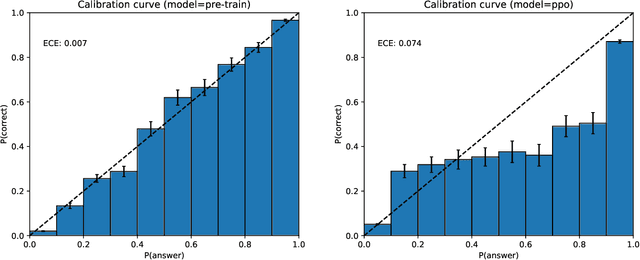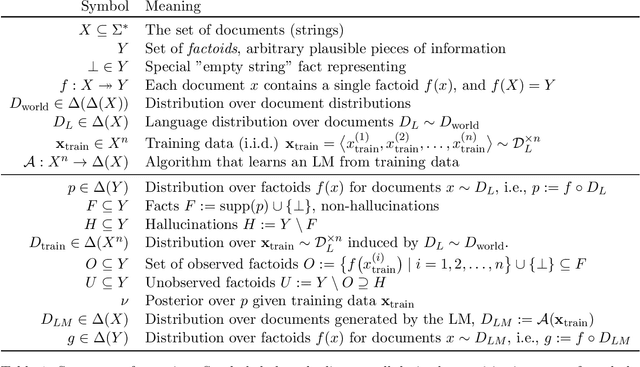Santosh S. Vempala
Why Language Models Hallucinate
Sep 04, 2025Abstract:Like students facing hard exam questions, large language models sometimes guess when uncertain, producing plausible yet incorrect statements instead of admitting uncertainty. Such "hallucinations" persist even in state-of-the-art systems and undermine trust. We argue that language models hallucinate because the training and evaluation procedures reward guessing over acknowledging uncertainty, and we analyze the statistical causes of hallucinations in the modern training pipeline. Hallucinations need not be mysterious -- they originate simply as errors in binary classification. If incorrect statements cannot be distinguished from facts, then hallucinations in pretrained language models will arise through natural statistical pressures. We then argue that hallucinations persist due to the way most evaluations are graded -- language models are optimized to be good test-takers, and guessing when uncertain improves test performance. This "epidemic" of penalizing uncertain responses can only be addressed through a socio-technical mitigation: modifying the scoring of existing benchmarks that are misaligned but dominate leaderboards, rather than introducing additional hallucination evaluations. This change may steer the field toward more trustworthy AI systems.
Faster logconcave sampling from a cold start in high dimension
May 03, 2025Abstract:We present a faster algorithm to generate a warm start for sampling an arbitrary logconcave density specified by an evaluation oracle, leading to the first sub-cubic sampling algorithms for inputs in (near-)isotropic position. A long line of prior work incurred a warm-start penalty of at least linear in the dimension, hitting a cubic barrier, even for the special case of uniform sampling from convex bodies. Our improvement relies on two key ingredients of independent interest. (1) We show how to sample given a warm start in weaker notions of distance, in particular $q$-R\'enyi divergence for $q=\widetilde{\mathcal{O}}(1)$, whereas previous analyses required stringent $\infty$-R\'enyi divergence (with the exception of Hit-and-Run, whose known mixing time is higher). This marks the first improvement in the required warmness since Lov\'asz and Simonovits (1991). (2) We refine and generalize the log-Sobolev inequality of Lee and Vempala (2018), originally established for isotropic logconcave distributions in terms of the diameter of the support, to logconcave distributions in terms of a geometric average of the support diameter and the largest eigenvalue of the covariance matrix.
Sampling and Integration of Logconcave Functions by Algorithmic Diffusion
Nov 20, 2024
Abstract:We study the complexity of sampling, rounding, and integrating arbitrary logconcave functions. Our new approach provides the first complexity improvements in nearly two decades for general logconcave functions for all three problems, and matches the best-known complexities for the special case of uniform distributions on convex bodies. For the sampling problem, our output guarantees are significantly stronger than previously known, and lead to a streamlined analysis of statistical estimation based on dependent random samples.
Does GPT Really Get It? A Hierarchical Scale to Quantify Human vs AI's Understanding of Algorithms
Jun 20, 2024Abstract:As Large Language Models (LLMs) perform (and sometimes excel at) more and more complex cognitive tasks, a natural question is whether AI really understands. The study of understanding in LLMs is in its infancy, and the community has yet to incorporate well-trodden research in philosophy, psychology, and education. We initiate this, specifically focusing on understanding algorithms, and propose a hierarchy of levels of understanding. We use the hierarchy to design and conduct a study with human subjects (undergraduate and graduate students) as well as large language models (generations of GPT), revealing interesting similarities and differences. We expect that our rigorous criteria will be useful to keep track of AI's progress in such cognitive domains.
Coin-Flipping In The Brain: Statistical Learning with Neuronal Assemblies
Jun 11, 2024Abstract:How intelligence arises from the brain is a central problem in science. A crucial aspect of intelligence is dealing with uncertainty -- developing good predictions about one's environment, and converting these predictions into decisions. The brain itself seems to be noisy at many levels, from chemical processes which drive development and neuronal activity to trial variability of responses to stimuli. One hypothesis is that the noise inherent to the brain's mechanisms is used to sample from a model of the world and generate predictions. To test this hypothesis, we study the emergence of statistical learning in NEMO, a biologically plausible computational model of the brain based on stylized neurons and synapses, plasticity, and inhibition, and giving rise to assemblies -- a group of neurons whose coordinated firing is tantamount to recalling a location, concept, memory, or other primitive item of cognition. We show in theory and simulation that connections between assemblies record statistics, and ambient noise can be harnessed to make probabilistic choices between assemblies. This allows NEMO to create internal models such as Markov chains entirely from the presentation of sequences of stimuli. Our results provide a foundation for biologically plausible probabilistic computation, and add theoretical support to the hypothesis that noise is a useful component of the brain's mechanism for cognition.
In-and-Out: Algorithmic Diffusion for Sampling Convex Bodies
May 02, 2024

Abstract:We present a new random walk for uniformly sampling high-dimensional convex bodies. It achieves state-of-the-art runtime complexity with stronger guarantees on the output than previously known, namely in R\'enyi divergence (which implies TV, $\mathcal{W}_2$, KL, $\chi^2$). The proof departs from known approaches for polytime algorithms for the problem -- we utilize a stochastic diffusion perspective to show contraction to the target distribution with the rate of convergence determined by functional isoperimetric constants of the stationary density.
Calibrated Language Models Must Hallucinate
Dec 03, 2023

Abstract:Recent language models generate false but plausible-sounding text with surprising frequency. Such "hallucinations" are an obstacle to the usability of language-based AI systems and can harm people who rely upon their outputs. This work shows shows that there is an inherent statistical lower-bound on the rate that pretrained language models hallucinate certain types of facts, having nothing to do with the transformer LM architecture or data quality. For "arbitrary" facts whose veracity cannot be determined from the training data, we show that hallucinations must occur at a certain rate for language models that satisfy a statistical calibration condition appropriate for generative language models. Specifically, if the maximum probability of any fact is bounded, we show that the probability of generating a hallucination is close to the fraction of facts that occur exactly once in the training data (a "Good-Turing" estimate), even assuming ideal training data without errors. One conclusion is that models pretrained to be sufficiently good predictors (i.e., calibrated) may require post-training to mitigate hallucinations on the type of arbitrary facts that tend to appear once in the training set. However, our analysis also suggests that there is no statistical reason that pretraining will lead to hallucination on facts that tend to appear more than once in the training data (like references to publications such as articles and books, whose hallucinations have been particularly notable and problematic) or on systematic facts (like arithmetic calculations). Therefore, different architectures and learning algorithms may mitigate these latter types of hallucinations.
Contrastive Moments: Unsupervised Halfspace Learning in Polynomial Time
Nov 02, 2023Abstract:We give a polynomial-time algorithm for learning high-dimensional halfspaces with margins in $d$-dimensional space to within desired TV distance when the ambient distribution is an unknown affine transformation of the $d$-fold product of an (unknown) symmetric one-dimensional logconcave distribution, and the halfspace is introduced by deleting at least an $\epsilon$ fraction of the data in one of the component distributions. Notably, our algorithm does not need labels and establishes the unique (and efficient) identifiability of the hidden halfspace under this distributional assumption. The sample and time complexity of the algorithm are polynomial in the dimension and $1/\epsilon$. The algorithm uses only the first two moments of suitable re-weightings of the empirical distribution, which we call contrastive moments; its analysis uses classical facts about generalized Dirichlet polynomials and relies crucially on a new monotonicity property of the moment ratio of truncations of logconcave distributions. Such algorithms, based only on first and second moments were suggested in earlier work, but hitherto eluded rigorous guarantees. Prior work addressed the special case when the underlying distribution is Gaussian via Non-Gaussian Component Analysis. We improve on this by providing polytime guarantees based on Total Variation (TV) distance, in place of existing moment-bound guarantees that can be super-polynomial. Our work is also the first to go beyond Gaussians in this setting.
Efficiently Sampling the PSD Cone with the Metric Dikin Walk
Aug 09, 2023Abstract:Semi-definite programs represent a frontier of efficient computation. While there has been much progress on semi-definite optimization, with moderate-sized instances currently solvable in practice by the interior-point method, the basic problem of sampling semi-definite solutions remains a formidable challenge. The direct application of known polynomial-time algorithms for sampling general convex bodies to semi-definite sampling leads to a prohibitively high running time. In addition, known general methods require an expensive rounding phase as pre-processing. Here we analyze the Dikin walk, by first adapting it to general metrics, then devising suitable metrics for the PSD cone with affine constraints. The resulting mixing time and per-step complexity are considerably smaller, and by an appropriate choice of the metric, the dependence on the number of constraints can be made polylogarithmic. We introduce a refined notion of self-concordant matrix functions and give rules for combining different metrics. Along the way, we further develop the theory of interior-point methods for sampling.
Computation with Sequences in the Brain
Jun 06, 2023Abstract:Even as machine learning exceeds human-level performance on many applications, the generality, robustness, and rapidity of the brain's learning capabilities remain unmatched. How cognition arises from neural activity is a central open question in neuroscience, inextricable from the study of intelligence itself. A simple formal model of neural activity was proposed in Papadimitriou [2020] and has been subsequently shown, through both mathematical proofs and simulations, to be capable of implementing certain simple cognitive operations via the creation and manipulation of assemblies of neurons. However, many intelligent behaviors rely on the ability to recognize, store, and manipulate temporal sequences of stimuli (planning, language, navigation, to list a few). Here we show that, in the same model, time can be captured naturally as precedence through synaptic weights and plasticity, and, as a result, a range of computations on sequences of assemblies can be carried out. In particular, repeated presentation of a sequence of stimuli leads to the memorization of the sequence through corresponding neural assemblies: upon future presentation of any stimulus in the sequence, the corresponding assembly and its subsequent ones will be activated, one after the other, until the end of the sequence. Finally, we show that any finite state machine can be learned in a similar way, through the presentation of appropriate patterns of sequences. Through an extension of this mechanism, the model can be shown to be capable of universal computation. We support our analysis with a number of experiments to probe the limits of learning in this model in key ways. Taken together, these results provide a concrete hypothesis for the basis of the brain's remarkable abilities to compute and learn, with sequences playing a vital role.
 Add to Chrome
Add to Chrome Add to Firefox
Add to Firefox Add to Edge
Add to Edge